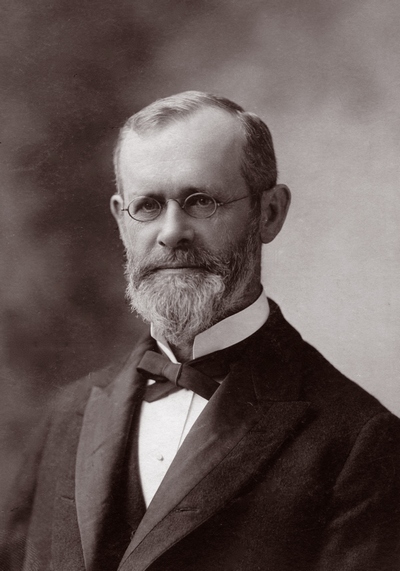Cleveland Abbe (Cleveland Abbe)

Cleveland Abbe was born in New York City and grew up in the prosperous merchant family of George Waldo and Charlotte Colgate Abbe. One of his younger brothers, Robert, became a prominent surgeon and radiologist. In school, Cleveland excelled in mathematics and chemistry, graduating in 1857 from the Free Academy. He then taught engineering for two years at the University of Michigan, while at the same time studying astronomy under Franz Brünnow. When the Civil War broke out, he tried to join the Union Army; however, he failed the vision test and spent the war years in Cambridge, Massachusetts, working as an assistant to Benjamin Gould, astronomer and head of the Longitude Department of the United States Coast Survey. He then studied abroad in Russia at the Observatory of Pulkovo and returned to the U.S. eager to study astronomy. In 1868 he was hired by the Cincinnati Astronomical Society, but the organization lacked funding and he lost his job less than a year later. He then made the decision that would change his career path. Remembering that meteorological conditions directly affected the work of astronomers, he began working in the field of meteorology. He won approval to report on and predict the weather, working on the premise that forecasts could and should be generated at minimal expense and in such a way as to perhaps even produce income.
Abbe was appointed chief meteorologist at the National Weather Service in 1871, which at the time was part of the Signal Corps. One of the first things that he addressed was the forecasting dimension of meteorology. He recognized that predicting the weather required a widespread, yet coordinated team. And so with short-term funding granted from the Cincinnati Chamber of Commerce, he enlisted twenty volunteer weather observers to help report conditions. Western Union agreed to permit the observers to communicate without charge, and Abbe and his team went to work. He selected data-collecting instruments that would be critical to the success of weather predicting, and he trained Army observer sergeants in their use. Field data was transmitted using code designed to minimize word count, and at the designated times, information flooded the transmission stations. Clerks would then decode and record the messages and manually enter data onto weather maps, which were then used to predict the weather.
On February 19, 1871, Abbe personally gave the first official weather report. He continued to forecast alone for the next six months, while simultaneously training others. He was joined in mid-1871 by two Army lieutenants and a civilian professor in giving reports, and the team was then able to rotate the heavy workload. Abbe demanded precise language in the forecasts and ensured that every forecast covered four key meteorological elements: weather (clouds and precipitation), temperature, wind direction, and barometric pressure. By the end of the first year of reporting, over 60 copies of weather charts had been sent to Congress, the press, and various scientific institutions. By 1872, Abbe regularly sent over 500 sets of daily maps and bulletins overseas in exchange for European meteorological data. Abbe also insisted on verifying predictions. During the first year of operation, in 1871, Abbe and his staff verified 69 percent of their predications; the annual report apologized for the other 31 percent, citing the time constraints as the cause.
In order to compile his information, Abbe required a time-keeping system that was consistent among the stations. To accomplish this he divided the United States into four standard time zones. In 1883, he convinced North American railroad companies to adopt his time-zone system. In 1884, Britain, which had already adopted its own standard time system for England, Scotland, and Wales, helped gather international consent for global time.
Abbe required that the weather service stay at the forefront of technology. Over time, the instrument division at the headquarters tested and calibrated thousands of devices and even began to design and build their own instruments. By the end of the century, self-registering equipment came into use, and the United States led the meteorological world with 114 Class I (automatic recording) observation stations. Anticipating an increase in international cooperation, Abbe began to seek quality instruments calibrated to international standards. He enlisted Oliver Wolcott Gibbs of Harvard and Arthur Wright of Yale to design improved equipment. For comparison purposes, Abbe ordered a barometer from Heinrich Wild (director of the Nicholas Central Observatory in Russia), as well as an anemometer and several types of hygrometers from Germany. Abbe then invented an anemobarometer to test the effect of chimney and window drafts on barometers in enclosed spaces.
Abbe was elected Associate Fellow of the American Academy of Arts and Sciences in 1884. In 1912 the Royal Meteorological Society presented him with the Symons Memorial Gold Medal, citing his contribution “to instrumental, statistical, dynamical, and thermo dynamical meteorology and forecasting.” In 1916 he was awarded the Public Welfare Medal from the National Academy of Sciences. Abbe died the same year after more than 45 years of outstanding scientific achievement. He was buried in Rock Creek Cemetery in Washington, DC.
Cleveland Abbe founded the scientific journal Monthly Weather Review in 1872. The Monthly Weather Review began as a government publication under the United States Army Signal Corps. In 1891, the Signal Office’s meteorological responsibilities were transferred to the Weather Bureau under the United States Department of Agriculture. The Weather Bureau published the review until 1970, when the bureau became part of the newly formed National Oceanic and Atmospheric Administration. NOAA published the review until the end of 1973. Since 1974, this well-respected scientific journal has been published by the American Meteorological Society.
Born
- December, 03, 1838
- USA
- New York, New York
Died
- October, 28, 1916
- USA
- Chevy Chase, Maryland
Cemetery
- Rock Creek Cemetery
- Washington D.C.
- USA



